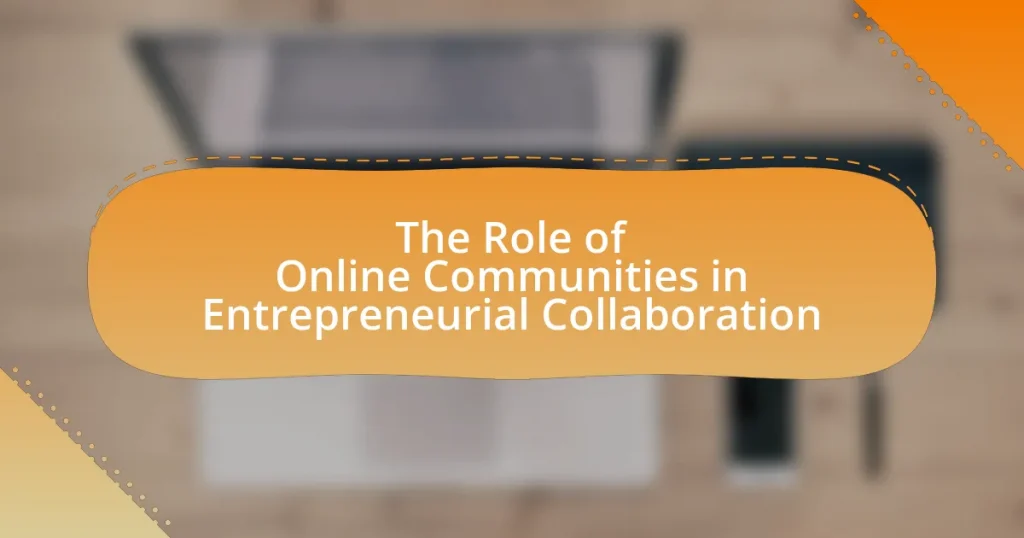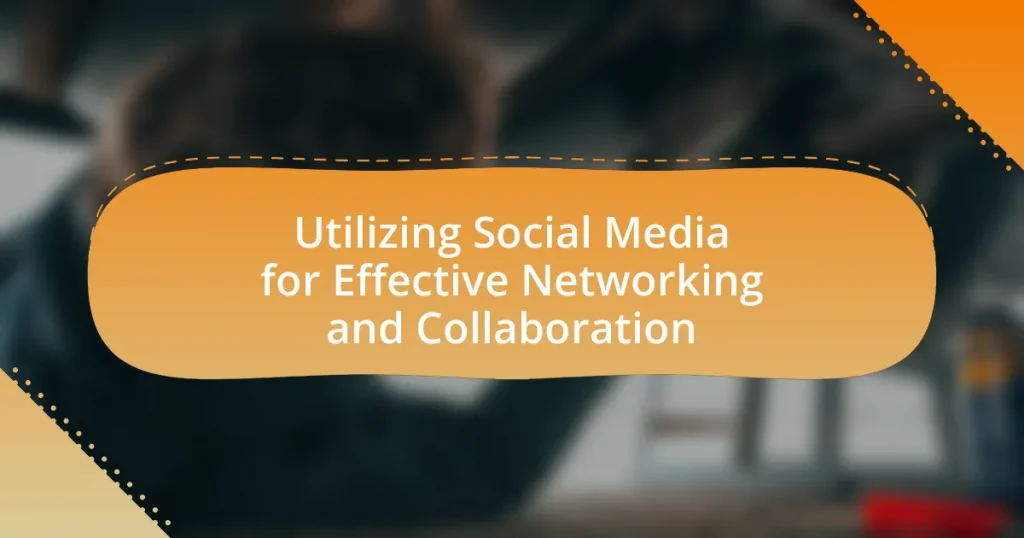Building a sustainable business model through innovative practices involves creating a framework that balances economic viability, social equity, and environmental protection by integrating sustainable practices into core operations. Key innovative practices include adopting circular economy models, renewable energy sources, and sustainable supply chain management, which contribute to long-term profitability and resilience. The article explores how innovation drives sustainability, the alignment of these practices with sustainable development goals, and the importance of stakeholder engagement. Additionally, it addresses challenges businesses face in implementing sustainable practices and highlights the role of technology in enhancing efficiency and reducing environmental impact.
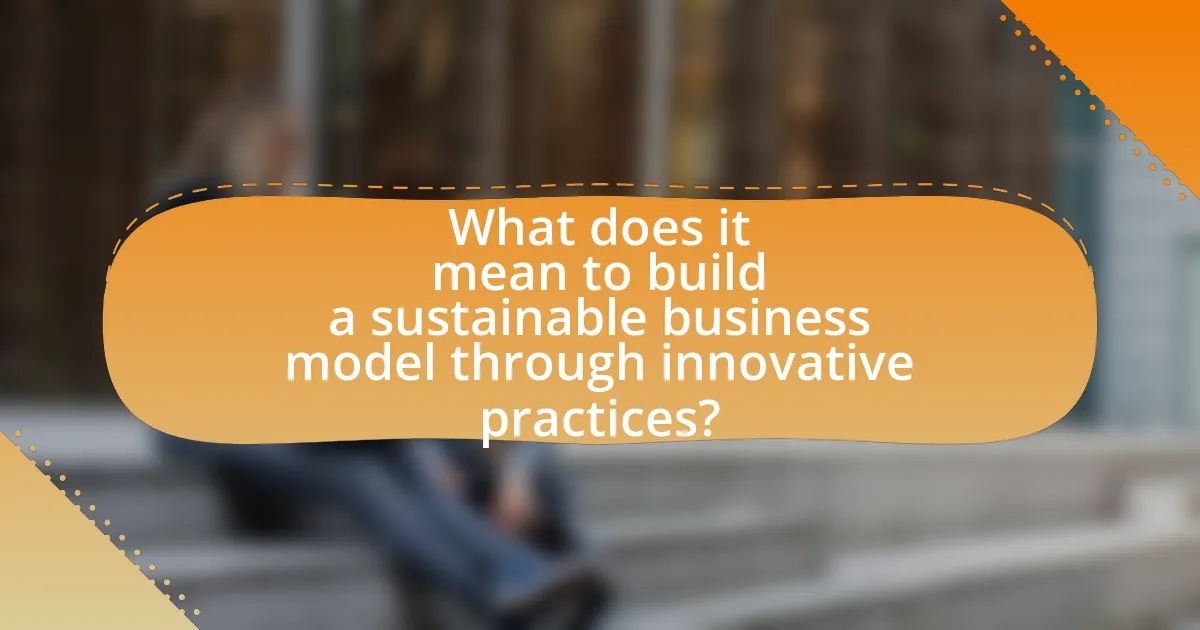
What does it mean to build a sustainable business model through innovative practices?
Building a sustainable business model through innovative practices means creating a framework that balances economic viability, social equity, and environmental protection while leveraging new ideas and technologies. This approach often involves integrating sustainable practices into core operations, such as using renewable resources, minimizing waste, and fostering community engagement. For instance, companies like Unilever have adopted sustainable sourcing and production methods, which not only reduce their environmental footprint but also enhance brand loyalty and customer trust. This dual focus on innovation and sustainability can lead to long-term profitability and resilience in a changing market landscape.
How can innovation drive sustainability in business models?
Innovation can drive sustainability in business models by introducing new technologies and practices that reduce environmental impact while enhancing efficiency. For instance, companies that adopt renewable energy sources, such as solar or wind power, significantly lower their carbon footprint and operational costs. A study by the International Renewable Energy Agency found that transitioning to renewable energy can reduce greenhouse gas emissions by up to 70% in certain sectors. Additionally, innovative practices like circular economy models, which focus on reusing materials and minimizing waste, can lead to sustainable resource management and cost savings. These approaches not only meet consumer demand for environmentally responsible products but also comply with increasing regulatory pressures for sustainability, thereby ensuring long-term viability and competitiveness in the market.
What are the key innovative practices that contribute to sustainability?
Key innovative practices that contribute to sustainability include circular economy models, renewable energy adoption, and sustainable supply chain management. Circular economy models focus on minimizing waste and maximizing resource use through recycling and reusing materials, which reduces environmental impact. Renewable energy adoption, such as solar and wind power, decreases reliance on fossil fuels and lowers greenhouse gas emissions. Sustainable supply chain management involves sourcing materials responsibly and ensuring ethical practices throughout the supply chain, which promotes environmental stewardship and social responsibility. These practices are supported by research indicating that companies implementing such strategies can enhance their competitiveness while contributing positively to environmental sustainability.
How do these practices align with sustainable development goals?
Innovative practices in building a sustainable business model align with sustainable development goals by promoting economic growth while ensuring environmental protection and social equity. For instance, implementing renewable energy solutions reduces carbon emissions, directly supporting Goal 7 (Affordable and Clean Energy) and Goal 13 (Climate Action). Additionally, practices such as sustainable sourcing and waste reduction contribute to Goal 12 (Responsible Consumption and Production) by minimizing resource depletion and promoting circular economy principles. These practices not only enhance business resilience but also foster community well-being, aligning with Goal 8 (Decent Work and Economic Growth) by creating job opportunities and improving livelihoods.
Why is sustainability important for modern businesses?
Sustainability is crucial for modern businesses because it enhances long-term viability and competitiveness. Companies that adopt sustainable practices can reduce costs through energy efficiency, waste reduction, and resource conservation. For instance, a study by McKinsey found that companies implementing sustainability initiatives can achieve cost savings of up to 60% in operational expenses. Furthermore, consumers increasingly prefer brands that demonstrate environmental responsibility, with 66% of global consumers willing to pay more for sustainable products, according to Nielsen. This shift in consumer behavior underscores the importance of sustainability in driving sales and brand loyalty.
What are the long-term benefits of adopting sustainable practices?
Adopting sustainable practices leads to long-term benefits such as cost savings, enhanced brand reputation, and improved regulatory compliance. Cost savings arise from reduced energy consumption and waste management expenses; for instance, companies implementing energy-efficient technologies can save up to 30% on energy costs, according to the U.S. Department of Energy. Enhanced brand reputation is achieved as consumers increasingly prefer environmentally responsible brands, with 66% of global consumers willing to pay more for sustainable products, as reported by Nielsen. Improved regulatory compliance occurs as businesses adopting sustainable practices are better positioned to meet evolving environmental regulations, reducing the risk of fines and legal issues.
How does sustainability impact brand reputation and customer loyalty?
Sustainability significantly enhances brand reputation and customer loyalty by aligning business practices with consumer values. Brands that prioritize sustainable practices are perceived as more trustworthy and responsible, which fosters a positive image. For instance, a 2021 study by Nielsen found that 81% of global consumers feel strongly that companies should help improve the environment. This consumer expectation translates into loyalty; brands like Patagonia, known for their environmental commitment, report high customer retention rates. Thus, sustainability not only bolsters brand reputation but also cultivates a loyal customer base, as consumers increasingly prefer to support businesses that reflect their values.
What challenges do businesses face when implementing sustainable practices?
Businesses face several challenges when implementing sustainable practices, including high initial costs, lack of expertise, and resistance to change. High initial costs can deter investment in sustainable technologies and processes, as many businesses may not see immediate financial returns. Additionally, a lack of expertise in sustainable practices can hinder effective implementation, as employees may require training and resources that are not readily available. Resistance to change often arises from established company cultures that prioritize short-term profits over long-term sustainability goals, making it difficult to shift mindsets and operational strategies. These challenges are supported by research from the World Economic Forum, which highlights that 70% of companies cite cost as a significant barrier to sustainability initiatives.
What are common barriers to innovation in sustainability?
Common barriers to innovation in sustainability include high costs, regulatory challenges, and lack of consumer demand. High costs often deter businesses from investing in sustainable technologies, as initial investments can be substantial. Regulatory challenges arise when existing laws and policies do not support or incentivize sustainable practices, creating a complex environment for innovation. Additionally, lack of consumer demand can limit the market for sustainable products, making it difficult for companies to justify the investment in innovation. According to a report by the World Economic Forum, 70% of executives cite financial constraints as a significant barrier to sustainability innovation, highlighting the critical impact of these factors on the advancement of sustainable practices.
How can businesses overcome these challenges?
Businesses can overcome challenges in building a sustainable business model through innovative practices by adopting a multi-faceted approach that includes leveraging technology, fostering a culture of innovation, and engaging stakeholders. For instance, integrating advanced technologies such as artificial intelligence and data analytics can enhance operational efficiency and reduce waste, which is crucial for sustainability. A study by the World Economic Forum highlights that companies utilizing AI can improve resource management by up to 30%. Additionally, fostering a culture of innovation encourages employees to contribute ideas that can lead to sustainable practices, as evidenced by companies like Unilever, which has successfully implemented employee-driven sustainability initiatives. Engaging stakeholders, including customers and suppliers, in sustainability efforts can also drive collective action and accountability, as demonstrated by the collaborative initiatives in the fashion industry aimed at reducing environmental impact.
How can businesses measure the success of their sustainable practices?
Businesses can measure the success of their sustainable practices through key performance indicators (KPIs) such as carbon footprint reduction, waste diversion rates, and energy efficiency improvements. These metrics provide quantifiable data that reflects the effectiveness of sustainability initiatives. For instance, a study by the Global Reporting Initiative indicates that companies implementing sustainability reporting see a 20% increase in stakeholder trust, which can be a direct measure of success. Additionally, tracking financial performance alongside sustainability efforts, such as cost savings from energy efficiency or increased sales from eco-friendly products, further validates the impact of sustainable practices.
What role does technology play in building sustainable business models?
Technology is essential in building sustainable business models as it enables efficiency, reduces waste, and fosters innovation. For instance, advancements in data analytics allow businesses to optimize resource use, leading to lower operational costs and minimized environmental impact. According to a report by the World Economic Forum, companies that leverage technology for sustainability can achieve up to 20% cost savings and significantly enhance their competitive advantage. Furthermore, technologies such as renewable energy systems and sustainable supply chain management tools directly contribute to reducing carbon footprints and promoting eco-friendly practices.
How can digital tools enhance innovative practices for sustainability?
Digital tools enhance innovative practices for sustainability by facilitating data collection, analysis, and collaboration, which drive informed decision-making. For instance, platforms like IoT sensors enable real-time monitoring of resource usage, allowing businesses to optimize energy consumption and reduce waste. Additionally, software solutions for supply chain management can identify inefficiencies and promote sustainable sourcing, leading to lower carbon footprints. Research from the World Economic Forum indicates that digital technologies can reduce global greenhouse gas emissions by up to 20% by 2030, demonstrating their significant impact on sustainability efforts.
What are examples of successful technology-driven sustainable business models?
Successful technology-driven sustainable business models include companies like Tesla, which utilizes electric vehicle technology to reduce carbon emissions, and Patagonia, which employs innovative supply chain practices to promote environmental sustainability. Tesla’s electric vehicles have contributed to a significant reduction in greenhouse gas emissions, with over 1.5 million cars sold globally by 2021, showcasing the effectiveness of its model. Patagonia’s commitment to using recycled materials and its “Worn Wear” program, which encourages customers to repair and reuse products, exemplifies a sustainable approach that has garnered a loyal customer base and increased brand value. These examples demonstrate how integrating technology with sustainability can lead to both environmental benefits and business success.
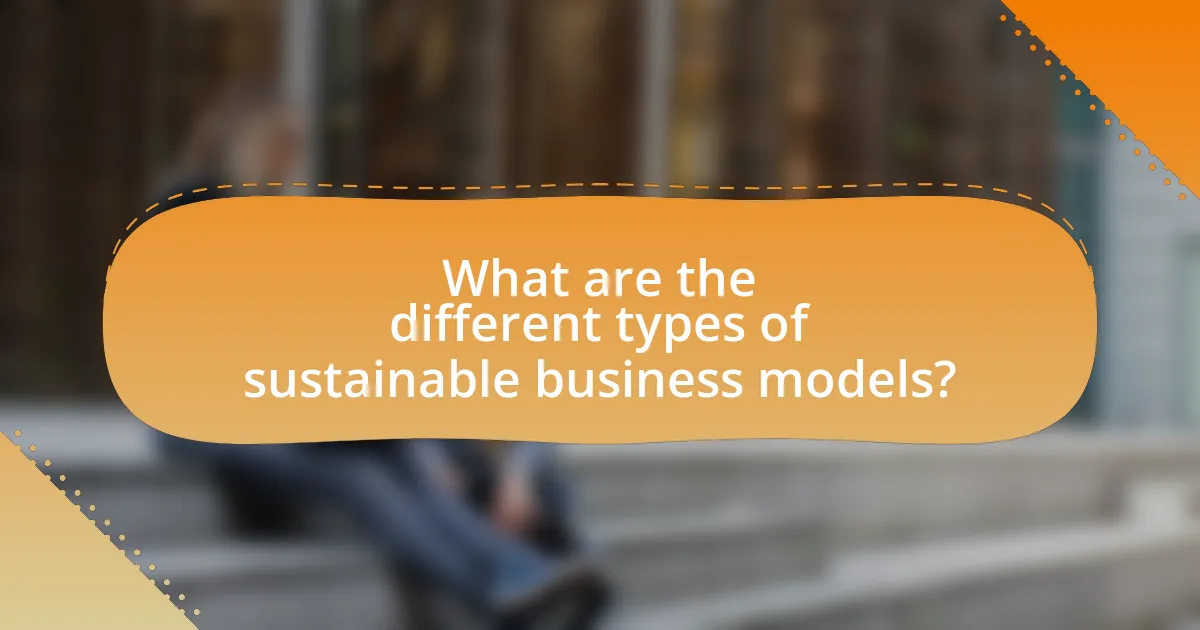
What are the different types of sustainable business models?
The different types of sustainable business models include circular economy, social enterprise, and B Corporation models. Circular economy models focus on resource efficiency and waste reduction by reusing materials and products, thereby minimizing environmental impact. Social enterprises prioritize social and environmental goals alongside profit, often reinvesting earnings into community initiatives. B Corporations meet rigorous standards of social and environmental performance, accountability, and transparency, balancing profit with purpose. These models are increasingly adopted as businesses recognize the importance of sustainability in driving long-term success and meeting consumer demand for responsible practices.
How do circular economy principles contribute to sustainability?
Circular economy principles contribute to sustainability by promoting resource efficiency and minimizing waste through the continuous use of materials. These principles encourage businesses to design products for longevity, repairability, and recyclability, which reduces the extraction of finite resources and lowers environmental impact. For instance, a study by the Ellen MacArthur Foundation highlights that transitioning to a circular economy could reduce global greenhouse gas emissions by 39% by 2030, demonstrating the significant potential for sustainability improvements.
What are the key components of a circular business model?
The key components of a circular business model include resource recovery, product life extension, and sustainable design. Resource recovery focuses on reclaiming materials from products at the end of their life cycle, which reduces waste and promotes recycling. Product life extension involves maintaining and repairing products to prolong their usability, thereby minimizing the need for new resources. Sustainable design emphasizes creating products that are easier to recycle or repurpose, ensuring that materials remain in use for as long as possible. These components collectively contribute to reducing environmental impact and promoting sustainability in business practices.
How can businesses transition from linear to circular models?
Businesses can transition from linear to circular models by adopting strategies that prioritize resource efficiency, waste reduction, and product lifecycle management. This involves redesigning products for longevity, enabling repair and reuse, and implementing take-back schemes to reclaim materials. For instance, companies like Philips have successfully shifted to circular practices by offering lighting as a service, which reduces waste and encourages sustainable consumption. Research indicates that transitioning to circular models can lead to a 70% reduction in resource use and a significant decrease in greenhouse gas emissions, demonstrating the environmental and economic benefits of such a shift.
What is the role of social entrepreneurship in sustainable business models?
Social entrepreneurship plays a crucial role in sustainable business models by integrating social and environmental objectives into their core operations. This approach not only addresses societal challenges but also creates economic value, fostering innovation and resilience. For instance, social enterprises often prioritize sustainable practices, such as using renewable resources or promoting fair trade, which can lead to long-term profitability while benefiting communities. Research indicates that businesses with a social mission can attract a growing consumer base that values ethical practices, as evidenced by a 2020 Nielsen report showing that 66% of global consumers are willing to pay more for sustainable brands. Thus, social entrepreneurship is essential for developing sustainable business models that align profit with purpose.
How do social enterprises balance profit and purpose?
Social enterprises balance profit and purpose by integrating social objectives into their business models while maintaining financial sustainability. They achieve this through strategies such as adopting a hybrid model that combines traditional revenue-generating activities with social impact initiatives, ensuring that both profit and purpose are prioritized. For instance, a study by the Stanford Social Innovation Review highlights that successful social enterprises often measure their impact using metrics that reflect both financial performance and social outcomes, allowing them to align their operations with their mission. This dual focus enables them to attract investors who are interested in both financial returns and social change, thereby reinforcing their ability to sustain operations while fulfilling their social mission.
What impact do social enterprises have on communities?
Social enterprises positively impact communities by addressing social issues while generating economic value. They create jobs, often targeting marginalized populations, which reduces unemployment rates and fosters economic inclusion. For instance, a study by the British Council found that social enterprises in the UK contributed £60 billion to the economy and employed over two million people, demonstrating their significant role in community development. Additionally, social enterprises often reinvest profits into local initiatives, enhancing community services such as education and healthcare, thereby improving overall quality of life.
How can businesses engage stakeholders in their sustainability efforts?
Businesses can engage stakeholders in their sustainability efforts by implementing transparent communication strategies and involving them in decision-making processes. For instance, companies can hold regular stakeholder meetings to discuss sustainability goals, gather feedback, and co-create initiatives. Research indicates that organizations with high stakeholder engagement in sustainability report a 20% increase in project success rates, demonstrating the effectiveness of collaborative approaches. Additionally, utilizing digital platforms for sharing progress and updates fosters a sense of community and accountability among stakeholders, further enhancing their involvement.
What strategies can be used to involve employees in sustainability initiatives?
To involve employees in sustainability initiatives, organizations can implement strategies such as creating cross-functional sustainability teams, offering training programs, and establishing incentive systems. Cross-functional teams encourage collaboration across departments, fostering a sense of ownership and accountability among employees. Training programs educate staff on sustainability practices and their impact, enhancing engagement and commitment. Incentive systems, such as recognition or rewards for sustainable practices, motivate employees to actively participate. Research from the Harvard Business Review indicates that companies with engaged employees in sustainability initiatives see a 30% increase in overall performance, demonstrating the effectiveness of these strategies.
How can businesses collaborate with external partners for greater impact?
Businesses can collaborate with external partners for greater impact by forming strategic alliances that leverage complementary strengths and resources. For instance, a technology company may partner with a non-profit organization to enhance its corporate social responsibility initiatives, thereby increasing its social impact while also improving its brand reputation. Research shows that companies engaging in partnerships can achieve up to 20% higher innovation rates, as highlighted in a study by the Harvard Business Review, which emphasizes the importance of collaboration in driving sustainable business practices.
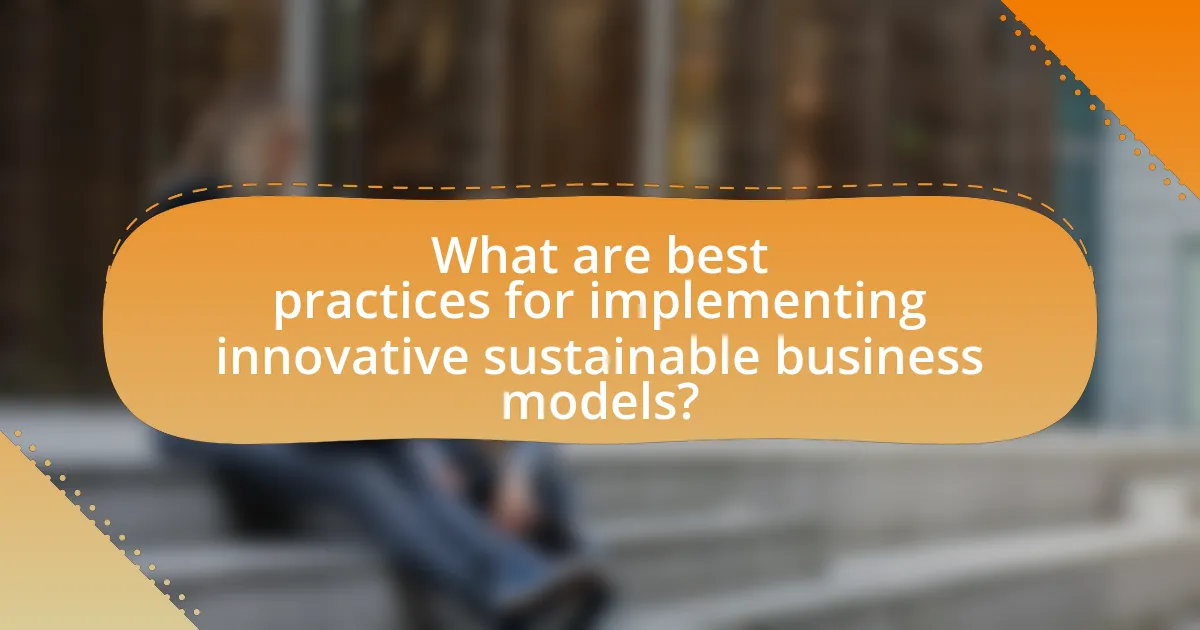
What are best practices for implementing innovative sustainable business models?
Best practices for implementing innovative sustainable business models include integrating sustainability into the core strategy, engaging stakeholders, and leveraging technology for efficiency. Companies that embed sustainability into their mission can align their operations with environmental and social goals, as seen in Unilever’s Sustainable Living Plan, which has driven growth while reducing environmental impact. Engaging stakeholders, including employees, customers, and suppliers, fosters collaboration and innovation, exemplified by Patagonia’s commitment to environmental activism and community involvement. Additionally, leveraging technology, such as data analytics and renewable energy solutions, enhances operational efficiency and reduces costs, as demonstrated by Tesla’s use of advanced battery technology to promote sustainable energy. These practices collectively contribute to the successful implementation of sustainable business models.
How can businesses foster a culture of innovation for sustainability?
Businesses can foster a culture of innovation for sustainability by integrating sustainability into their core values and encouraging collaborative problem-solving. This approach involves creating cross-functional teams that focus on sustainable practices, which can lead to innovative solutions that reduce environmental impact. For instance, companies like Unilever have successfully implemented sustainability initiatives that not only enhance their brand reputation but also drive cost savings and efficiency, demonstrating that sustainability can be a catalyst for innovation. Additionally, providing employees with training and resources to explore sustainable technologies and practices can further stimulate creative thinking and engagement in sustainability efforts.
What leadership strategies support sustainable innovation?
Leadership strategies that support sustainable innovation include fostering a culture of collaboration, encouraging risk-taking, and prioritizing long-term vision over short-term gains. These strategies create an environment where team members feel empowered to share ideas and experiment with new solutions. For instance, companies like Unilever have implemented open innovation platforms that invite external contributions, leading to sustainable product development. Additionally, leaders who emphasize sustainability in their mission and values can align their teams towards common goals, as seen in Tesla’s commitment to renewable energy, which drives innovation in electric vehicles. These approaches not only enhance creativity but also ensure that innovation aligns with sustainable practices, ultimately contributing to a more resilient business model.
How can employee training enhance innovative practices?
Employee training enhances innovative practices by equipping staff with the necessary skills and knowledge to think creatively and solve problems effectively. When employees undergo training, they gain exposure to new ideas, technologies, and methodologies that can inspire innovative thinking. For instance, a study by the Association for Talent Development found that organizations with comprehensive training programs are 218% more likely to report high levels of innovation. This correlation indicates that well-trained employees are more adept at generating and implementing innovative solutions, ultimately contributing to a sustainable business model.
What are practical steps for businesses to start their sustainability journey?
Businesses can start their sustainability journey by conducting a sustainability assessment to identify their environmental impact and areas for improvement. This assessment helps businesses understand their carbon footprint, waste generation, and resource consumption. Following the assessment, companies should set clear, measurable sustainability goals, such as reducing energy use by 20% within five years or achieving zero waste to landfill by a specific date.
Next, businesses should engage employees and stakeholders in sustainability initiatives, fostering a culture of sustainability through training and awareness programs. Implementing sustainable practices, such as sourcing materials responsibly, optimizing supply chains, and adopting energy-efficient technologies, is crucial.
Finally, businesses should regularly monitor and report their sustainability progress, using frameworks like the Global Reporting Initiative (GRI) to ensure transparency and accountability. Research indicates that companies with strong sustainability practices can enhance their brand reputation and achieve cost savings, as seen in a 2020 study by McKinsey, which found that companies with robust sustainability strategies outperform their peers financially.
How can businesses assess their current sustainability practices?
Businesses can assess their current sustainability practices by conducting a comprehensive sustainability audit. This audit involves evaluating environmental impact, resource usage, waste management, and social responsibility initiatives. For instance, a study by the Global Reporting Initiative indicates that organizations using sustainability reporting frameworks can identify gaps and opportunities for improvement, leading to enhanced performance and accountability. By analyzing metrics such as carbon footprint, energy consumption, and supply chain sustainability, businesses can gain insights into their practices and make informed decisions to enhance their sustainability efforts.
What resources are available for businesses looking to innovate sustainably?
Businesses looking to innovate sustainably can access various resources, including government grants, sustainability-focused incubators, and online platforms that provide tools and frameworks for sustainable innovation. For instance, the U.S. Small Business Administration offers grants specifically aimed at promoting sustainable practices, while organizations like the Ellen MacArthur Foundation provide resources and case studies on circular economy principles. Additionally, platforms such as the Global Reporting Initiative offer guidelines for sustainability reporting, helping businesses measure and communicate their sustainability efforts effectively. These resources support businesses in integrating sustainable practices into their operations and strategies.
What are the future trends in sustainable business models?
Future trends in sustainable business models include circular economy practices, increased reliance on renewable energy, and the integration of technology for sustainability. Circular economy practices focus on minimizing waste and maximizing resource use, as seen in companies like Unilever, which aims to make all of its plastic packaging recyclable or reusable by 2025. The shift towards renewable energy is evidenced by major corporations like Google committing to operate on 100% renewable energy, reflecting a broader industry trend. Additionally, technology integration, such as blockchain for supply chain transparency, is becoming essential; for instance, IBM’s Food Trust uses blockchain to enhance food safety and sustainability. These trends indicate a significant movement towards more sustainable and responsible business practices.
How will consumer behavior influence sustainable practices in the future?
Consumer behavior will significantly influence sustainable practices in the future by driving demand for eco-friendly products and services. As consumers increasingly prioritize sustainability, businesses will adapt their practices to meet these expectations, leading to innovations in product design, sourcing, and waste management. For instance, a 2021 survey by Nielsen found that 73% of global consumers are willing to change their consumption habits to reduce environmental impact, indicating a strong market shift towards sustainability. This consumer-driven demand will compel companies to adopt sustainable practices, such as using renewable materials and implementing circular economy principles, to remain competitive and relevant in the marketplace.
What emerging technologies are likely to shape sustainable business models?
Emerging technologies likely to shape sustainable business models include artificial intelligence (AI), blockchain, and renewable energy technologies. AI enhances efficiency and decision-making in resource management, enabling businesses to optimize operations and reduce waste. Blockchain provides transparency and traceability in supply chains, fostering trust and accountability, which are crucial for sustainable practices. Renewable energy technologies, such as solar and wind, facilitate the transition to low-carbon energy sources, significantly decreasing environmental impact. According to a report by the International Renewable Energy Agency, the global renewable energy sector has seen a 10% annual growth rate, underscoring its potential to transform business models towards sustainability.
What are key takeaways for building a sustainable business model through innovative practices?
Key takeaways for building a sustainable business model through innovative practices include integrating sustainability into core operations, leveraging technology for efficiency, and fostering a culture of continuous improvement. Integrating sustainability ensures that environmental and social considerations are part of decision-making, which can lead to long-term viability and customer loyalty. Leveraging technology, such as data analytics and automation, enhances operational efficiency and reduces waste, contributing to sustainability goals. Fostering a culture of continuous improvement encourages innovation and adaptability, allowing businesses to respond to changing market demands and environmental challenges effectively. These practices are supported by studies indicating that companies prioritizing sustainability can achieve better financial performance and competitive advantage.

